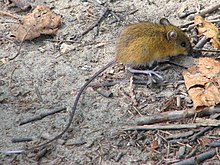Woodland jumping mouse
[2] Representatives of the family Dipodidae are found in the northern regions of the Old and New Worlds, and are characterized by very large infraorbital foramen, and, in one of the two North American genera, Zapus, by four upper cheek teeth.[3] The woodland jumping mouse was originally classified as Zapus insignis in 1891, but differences detected in dental morphology, ear ossicles, and the baculum resulted in the creation of two new genera, Napaeozapus and Eozapus.[8] One hundred three mice taken in central New York had stomach contents containing the fungi of the genus Endogone and related genera.During this time, the mating season begins; mice that re-emerged from hibernation eat much food to restore body weight and fat.Some mice do not enter hibernation, but move to nearby peoples' houses to live inside the walls, in old furniture, or cabinets.Parental care is little understood because observation in the wild is difficult and females in captivity normally commit infanticide shortly after giving birth.[4] Eastern screech owls, timber rattlesnakes, bobcats, broad-banded copperheads, American mink, weasels, and striped skunks are known predators.[4] No major threats exist at present (2010) but land development reduces suitable habitat for species hibernation, and insufficient layers of insulating snowfall may result in high death rates during the winter.More research is needed to evaluate and assess current distribution, species abundance, and potential effects of threats.No conservation measures have been undertaken at present to address specific needs of populations in state and national parks.The IUCN has listed the species as Least Concern, because the mouse is common and widespread, populations are considered stable, and no major threats exist at present.

PleistoceneConservation statusLeast ConcernIUCN 3.1Scientific classificationEukaryotaAnimaliaChordataMammaliaRodentiaZapodidaePrebleBinomial nameG. S. Millerjumping mouseinfraorbital foramenIncisorshibernatorsdental morphologyear ossiclesbaculumNapaeozapusEozapusDipodidaeNew BrunswickOntarioQuebecNorth CarolinaWisconsinMichiganspeciesnominate subspeciesborealsprucehemlockhardwoodstouch-me-notsImpatiensmeadowSturgeon River Provincial ParkSheffield, VermontpremolarsmolarshypsodontvertebraeBasal metabolic rateSmoky Mountainsdiploid numberTooth FormulaMammaeabdominalMetabolismbody temperatureBody masscentral New YorkEndogoneolfactionTouch-me-nothibernationmating seasonhypothermiagestationinfanticideviviparousSexual dimorphismGompertz functionEastern screech owlstimber rattlesnakesbobcatsbroad-banded copperheadsAmerican minkweaselsstriped skunksIUCN Red Listspecies abundanceIUCN Red List of Threatened SpeciesCornell University PressMichigan State University PressJournal of MammalogyUniversity of Michigan PressSmithsonian National Museum of Natural HistoryBaltimoreJohns Hopkins PressWikispeciesMyomorphaDipodoideaSicistinaeSicistaArmenian birch mouse (Sicista armenica)Northern birch mouse (Sicista betulina)Caucasian birch mouse (Sicista caucasica)long-tailed birch mouse (Sicista caudata)Chinese birch mouse (Sicista concolor)Kazbeg birch mouse (Sicista kazbegica)Kluchor birch mouse (Sicista kluchorica)Nordmann's birch mouse (Sicista loriger)Altai birch mouse (Sicista napaea)gray birch mouse (Sicista pseudonapaea)Severtzov's birch mouse (Sicista severtzovi)Strand's birch mouse (Sicista strandi)Southern birch mouse (Sicista subtilis)Tien Shan birch mouse (Sicista tianshanica)Hungarian birch mouse (Sicista trizona)ZapodinaeChinese jumping mouse (Eozapus setchuanus)Meadow jumping mouse (Zapus hudsonius)Western jumping mouse (Zapus princeps)Pacific jumping mouse (Zapus trinotatus)AllactaginaeJerboasAllactagaIranian jerboa (Allactaga firouzi)Hotson's jerboa (Allactaga hotsoni)great jerboa (Allactaga major)Svertzov's jerboa (Allactaga severtzovi)Balikun jerboa (Allactaga balikunica)Gobi jerboa (Allactaga bullata)Mongolian five-toed jerboa (Allactaga sibirica)AllactodipusBobrinski's jerboa (Allactodipus bobrinskii)Pygeretmuslesser fat-tailed jerboa (Pygeretmus platyurus)dwarf fat-tailed jerboa (Pygeretmus pumilio)greater fat-tailed jerboa (Pygeretmus shitkovi)Scarturussmall five-toed jerboa (Scarturus elater)